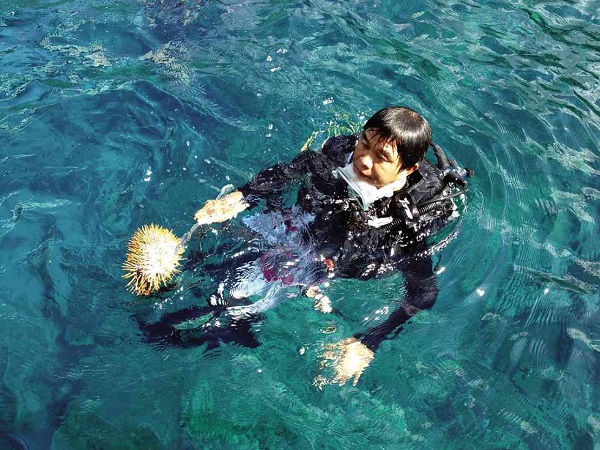Crown of thorns outbreak found in Batangas

A DIVER rises to the surface with a crown of thorns starfish removed from the coral reef in Barangay Pinagkilatan, Batangas City. MARRAH ERIKA LESABA/INQUIRER SOUTHERN LUZON
BATANGAS CITY—An outbreak of the poisonous crown of thorn starfish (COTS) has been reported in the sea off a coastal village here, threatening corals in the waters that form part of Isla Verde Passage.
Jacob Meimban Jr., executive director of the Protected Areas and Wildlife Bureau-Coastal and Marine Management Office (PAWB-CMMO) here, said they discovered and declared a COTS (Acanthasterplanci) outbreak in the waters of Barangay Pagkilatan, a 10-square-kilometer village along Verde Island Passage, which has been declared the center of marine biodiversity in the world.
He said a COTS outbreak means that there are hundreds of the starfish species in one coral reef and that these are too big to be eaten by their predators—mostly fish.
COTS are a class of starfish that become pests if its reproduction is not controlled. It destroys the habitat of fish and other marine animals.
Manual task
Article continues after this advertisementThe presence of COTS in the area is so alarming that the PAWB-CMMO organized on Tuesday a dive for a group of about 30 enthusiasts that included celebrity couple Luis Manzano and Jennelyn Mercado to remove the thorny starfish one by one from the corals.
Article continues after this advertisementManzano, son of Batangas Gov. Vilma Santos-Recto, is an advocate of coral reef preservation along with girlfriend Mercado. They had been conferred the title of Ambassadors for Sustainable Coral Reef Ecosystems Management Program by the PAWB-CMMO.
In April, divers were able to remove 100 COTS and on Tuesday, they collected 135 with an average diameter of 12 inches, Meimban said.
The 30 divers used tongs to remove the COTS. “They have to be clipped and not nudged or else they will grow in number, their toxin will spread and the eggs they produce could get buried in a hole that’s about 6-feet deep,” Meimban said.
Deep disease
He said a COTS outbreak is not immediately visible on the surface since the starfish are attached to the corals and could only be seen 20 feet deep in the water.
A COTS’ surface has venomous sharp spines that look like a crown. It is one of the largest kinds of starfish and can reach up to 20 inches in diameter. It preys on hard, stony or branching corals.
COTS are also dangerous to humans. A COTS’ prick causes stinging pain, bleeding, nausea and swelling, which may last a week. Spines broken off may be embedded in the skin, requiring minor surgery to remove, he added.
Meimban also said that COTS feed on living coral tissues that could destroy whole populations of corals. They absorb nutrients, leaving a white scar on coral surfaces. COTS grow and multiply rapidly as a result of climate change, overfishing and pollution.